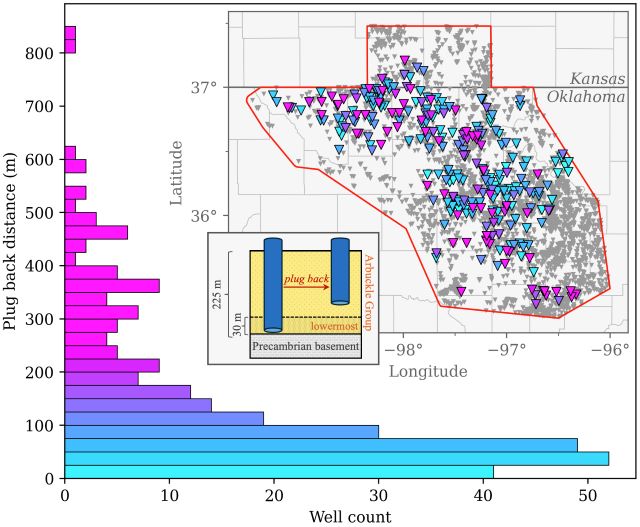13 November 2024–Wastewater injection resulting from oil and gas production in Oklahoma caused a dramatic rise in seismic activity in the state between 2009 and 2015. But regulatory efforts to backfill some injection wells with cement and reduce injection volumes have been effective in lowering the state’s induced earthquake rate, according to a new study in The Seismic Record.
The study by Robert Skoumal of the U.S. Geological Survey and colleagues lends further support to the idea that reducing the depth of wastewater injection can decrease seismic activity—a finding that could have implications for controlling the rise of induced seismicity in west Texas and eastern New Mexico.
“Each basin is different, but we’ve repeatedly seen the connection between injection depth and the likelihood of inducing earthquakes across the country,” Skoumal said.
In 2015, the Oklahoma Corporation Commission (OCC) mandated that wells injecting water into the lower portion of a sedimentary formation called the Arbuckle Group—which lays on top of the region’s basement rock—must be backfilled with cement to limit injection to shallower levels.
If these “plug-backs” had been applied to only half of the volume injected into the lower Arbuckle, the 2024 seismicity rate in Oklahoma would be about 2.5 times larger than it is under the current plug back scenario, the researchers concluded.
If no plug backs were in place, the seismicity rate would be about 4.4 times larger.
“It’s the first time we’ve had the opportunity to look at the influence that reducing injecting depths has on induced earthquakes across such a large, regional scale,” said Skoumal.

“The science said proximity to the basement matters, and the OCC reduced the proximity of those wells,” he added. “This study is confirmation that those plug back efforts successfully reduced the earthquake rates.”
Hydrocarbon production in Oklahoma is connected to a rise in earthquake rates starting around 2009 and peaking in 2015, when there were 888 magnitude 3 or larger earthquakes in the state. There have been five earthquakes of magnitude 5 or larger, including the 2011 Prague and the 2016 Pawnee earthquakes that caused notable damage.
Numerous studies, including some by the TSR authors, demonstrate that this rise in seismicity was primarily related to wastewater disposal into the Arbuckle in central Oklahoma. From an industry perspective, the formation was ideal for disposal, Skoumal said.
“It has a very high permeability, meaning fluids will rapidly flow away from the well, making room for more fluid. It is underpressured, meaning water can be ‘poured’ down a well without using pumps, and it’s easily accessible across the region,” he noted. “For every gallon of oil they were bringing up, 10 gallons of water came up with it. There was a tremendous volume of fluid that had to go somewhere, and the Arbuckle was an economical place to dispose of it.”
Earthquake rates have declined in the state since their 2015 peak, in part due to economic factors that led to less oil production in the area, and therefore less wastewater injection. To discover whether the plug backs and volume reductions led to less induced seismicity, Skoumal and his colleagues created several earthquake models that use data on plug backs, total wastewater injection volumes and the observed earthquake rates.
They found that a model that considered only wastewater volumes injected into the lower Arbuckle, and had plug backs fully effective at reducing earthquake rates, provided the best explanation for patterns in the observed seismicity rates.
While induced seismicity rates have fallen in Oklahoma, they are on the rise in the Permian Basin of western Texas and southeastern New Mexico which has experienced six magnitude 5 and larger earthquakes since 2020. “We find the combination of reducing volumes and plugging back wells were effective in Oklahoma, and it could be an effective strategy elsewhere,” Skoumal said.
